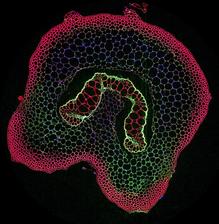Synchrotron micro-fluorescence computed tomographic reconstruction of a slice through the rachis (stem) of the fern. It shows arsenic in green, X-ray Compton in red and X-ray Absorption in blue. (Credit: DESY/Wageningen University & Research, Kathryn Spiers, Dennis Brückner/Antony van der Ent)
With the micro-X-ray image of a fern stalk taken at DESY, researchers have won second place in the annual Helmholtz competition for the best science images. Helmholtz Imaging chose the best visualisations on Thursday evening at its annual meeting at DESY in Hamburg. First place went to Helmholtz Zentrum München (HMGU), and third place to a collaboration between the German Aerospace Center (DLR) and the Alfred Wegener Institute (AWI).
The tropical fern Pteris vittata has the exceptional ability to naturally accumulate arsenic into its living tissues. This feat makes it a prime candidate for cleaning up poisoned soils. Arsenic is a problem in many places. It enters the environment through mining, for example, but certain microorganisms also release arsenic. There are thousands of poisoned areas worldwide.
At beamline P06 of DESY's X-ray light source PETRA III, DESY scientists Kathryn Spiers and Dennis Brückner, together with plant ecophysiologist Anthony van der Ent from Wageningen University, investigated exactly where the fern stores the semimetal. The award-winning image is a synchrotron micro-fluorescence computed tomographic reconstruction of a slice through the rachis (stem) of the fern. It shows arsenic in green and reveals that arsenic is localised in the endodermis and pericycle surrounding the vascular bundles. The elemental maps help to better understand the molecular and physiological mechanisms of arsenic tolerance in this fern. This information is used to study and improve its natural ability to accumulate arsenic for cleaning up soils.
The Helmholtz Imaging visualisation competition has been held for the third time. First place in this year's jury's selection went to Lin Yang of Helmholtz Zentrum München for an image of the delicate architecture of lung alveoli. Third place went to Angelika Humbert of AWI and Tilman Bucher of DLR for an aerial photograph of a drained glacial lake on Greenland. Prizes were also awarded for the images most popular with the public and among the participants.
(from DESY News)
https://helmholtz-imaging.de







